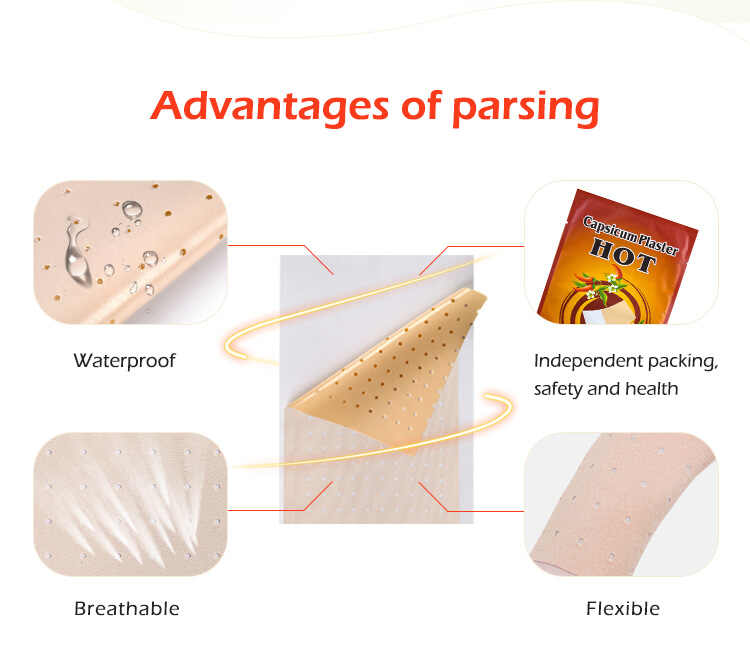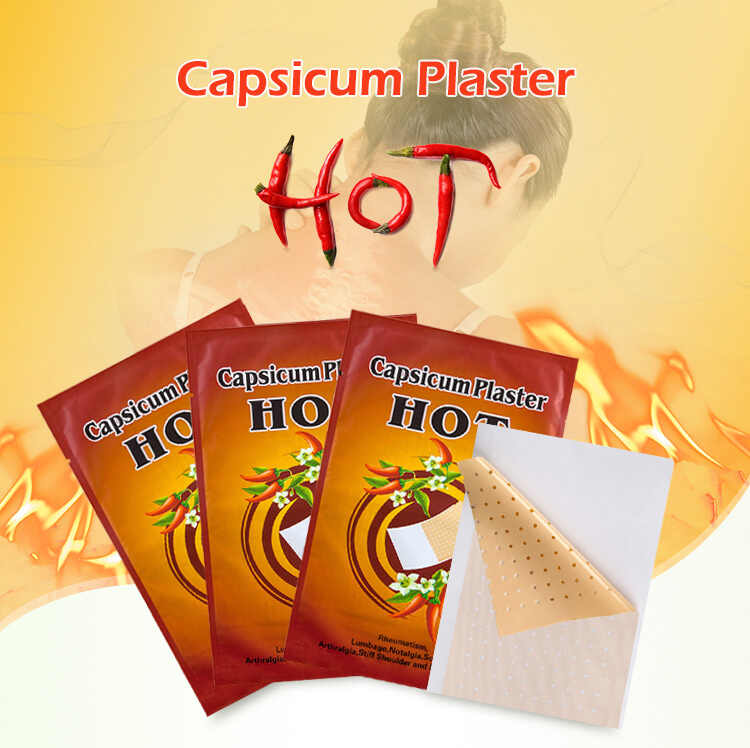What’s the Difference Between OEM and Private Label Capsicum Heat Plaster?
As global demand for natural pain relief solutions continues to rise, Capsicum Heat Plaster products have become a popular option for both consumers and businesses. For companies looking to enter this market or expand their product line, two common manufacturing options are often considered: OEM (Original Equipment Manufacturer) and Private Label. But what exactly is the difference between them?
Understanding the distinction between OEM Capsicum Heat Plaster and Private Label Capsicum Heat Plaster is essential when working with a Capsicum Heat Plaster Manufacturer or Capsicum Heat Plaster Supplier. This article provides a comprehensive and persuasive overview of the two models, helping you choose the right path for your business.

Understanding Capsicum Heat Plaster: A Quick Overview
Capsicum Heat Plaster is a type of transdermal patch made with capsaicin, the active component of chili peppers. It provides natural pain relief by stimulating blood flow, reducing inflammation, and blocking pain signals.
Whether you're sourcing from a Custom Capsicum Heat Plaster Manufacturer or working with a Capsicum Heat Plaster OEM, these products are widely used for conditions such as:
Muscle pain and soreness
Joint pain (arthritis, bursitis)
Back and neck stiffness
Sports injuries
Now let’s delve into the two business models available when sourcing these therapeutic plasters.
What is OEM Capsicum Heat Plaster?
OEM (Original Equipment Manufacturer) means a Capsicum Heat Plaster Manufacturer produces a product according to your specifications but under your brand name. You typically control the formula, design, materials, and packaging.
Key Features of Capsicum Heat Plaster OEM:
Full Customization: You can create a unique formula, choose specific ingredients, and design your packaging.
Higher Initial Investment: OEM requires larger MOQs (Minimum Order Quantities) and development costs.
Exclusive Product Offering: Since the product is made to your exact specs, it's not available to your competitors.
Time-Consuming Setup: You may need R&D time, testing, and regulatory approvals, depending on your region.
When to Choose OEM:
If you're launching a premium product line or want complete control over your brand’s formulation and image, working with a Capsicum Heat Plaster OEM is your best option.
What is Private Label Capsicum Heat Plaster?
In a Private Label model, the Capsicum Heat Plaster Supplier already has ready-made formulations. You simply apply your own branding and packaging design to the existing product.
Key Features of Private Label Capsicum Heat Plaster:
Faster Time-to-Market: Products are pre-developed and tested, so you can launch quickly.
Lower MOQs: Ideal for startups or small businesses due to minimal entry costs.
Limited Customization: You can customize branding and packaging, but not the core formula.
Proven Formulations: You benefit from well-tested and stable products without having to handle R&D.
When to Choose Private Label:
If you're new to the market or want to test a product concept with minimal risk, Private Label Capsicum Heat Plaster offers a smart and efficient route.
OEM vs. Private Label: A Side-by-Side Comparison
| Feature | OEM Capsicum Heat Plaster | Private Label Capsicum Heat Plaster |
|---|---|---|
| Formula | Customizable | Pre-formulated |
| Packaging Design | Fully Custom | Limited to label and packaging |
| Time to Market | Longer (4–6 months typical) | Fast (as little as 2–4 weeks) |
| MOQ | High | Low |
| Cost | Higher setup and development cost | Lower entry cost |
| Flexibility | Full control over product specs | Limited to branding changes |
| Exclusivity | Product exclusive to your brand | May be sold to multiple brands |
How to Choose the Right Model for Your Business
Both OEM and Private Label have strategic advantages. Here’s how to choose the right one:
1. Consider Your Business Stage
Startups or small enterprises may benefit from Private Label Capsicum Heat Plaster due to low capital risk.
Established brands with a strong customer base might opt for OEM Capsicum Heat Plaster to create exclusive formulations.
2. Evaluate Your Resources
OEM requires time, technical support, and investment. Make sure you have access to:
Formulation consultants
Legal/regulatory experts
Marketing and design teams
Private Label, by contrast, offers a plug-and-play solution for quicker revenue.
3. Define Your Brand Strategy
If brand differentiation is crucial, Custom OEM solutions allow you to deliver unique features, such as:
Herbal infusions
Enhanced capsaicin levels
Skin-soothing additives (e.g., menthol, camphor)
A Private Label approach, on the other hand, is ideal for filling gaps in your product line or responding to market demand quickly.
Why Partnering with the Right Manufacturer Matters
Whether you're choosing OEM or Private Label, the success of your product depends on choosing a reliable Capsicum Heat Plaster Manufacturer or Capsicum Heat Plaster Supplier.
What to Look For:
GMP & ISO Certifications: Ensures manufacturing quality and hygiene.
Regulatory Compliance: Meets FDA, CE, or other regional safety standards.
Experience in Customization: Proven track record with Custom Capsicum Heat Plaster projects.
Production Scalability: Capacity to grow with your business.
Transparent Communication: Clear process, timelines, and support.
Working with a trusted Capsicum Heat Plaster OEM ensures your brand is backed by consistency, quality, and compliance.
Key Advantages of Each Model
✅ OEM Model Benefits:
Unique selling proposition (USP)
Exclusive distribution rights
Brand consistency from formula to packaging
✅ Private Label Model Benefits:
Fast product launch
Low investment risk
Easier testing of new markets or regions
Real-World Scenarios
Example 1: A Sports Brand
A fitness company wants to launch a custom muscle recovery patch. By partnering with a Capsicum Heat Plaster OEM, they develop a high-strength formula with added menthol and vitamin E. The product is marketed as a professional-grade solution for athletes.
Example 2: A Health Retailer
A wellness store wants to add a heat patch to its existing natural remedy collection. They choose a Private Label Capsicum Heat Plaster Supplier to quickly introduce a reliable, tested product under their brand. They skip the R&D process and start selling within 3 weeks.
How to Start: Tips for Success
Define Your Vision: Know your target audience and how your Capsicum Heat Plaster will serve them.
Choose the Right Manufacturer: Vet your potential Capsicum Heat Plaster Supplier thoroughly.
Decide on Model: Evaluate OEM vs. Private Label based on your timeline and budget.
Start with a Pilot Run: Consider beginning with smaller quantities to test the market.
Focus on Compliance: Ensure labeling, claims, and certifications align with your region's regulations.
Conclusion
Understanding the difference between OEM and Private Label models is critical for positioning your brand in the growing natural pain relief market. Whether you're aiming for a fully Custom Capsicum Heat Plaster or prefer a fast-track approach with Private Label Capsicum Heat Plaster, working with a reputable Capsicum Heat Plaster Manufacturer is key to long-term success.
Both options can be highly profitable — the choice depends on your business model, brand strategy, and resources. With the right Capsicum Heat Plaster OEM partner or supplier, you can create a product line that resonates with consumers and strengthens your market presence.
Related Questions and Answers
Q1: Can I customize the ingredients in a Private Label Capsicum Heat Plaster?
A: No, Private Label typically uses a fixed formula. For ingredient changes, choose OEM.
Q2: What certifications should a reliable Capsicum Heat Plaster Manufacturer have?
A: Look for GMP, ISO, FDA, and CE certifications to ensure product safety and compliance.
Q3: How long does it take to develop a Custom Capsicum Heat Plaster through OEM?
A: Development can take 4–6 months, including formulation, testing, and packaging design.
Q4: What is the MOQ for Private Label Capsicum Heat Plaster?
A: MOQs can be as low as 1,000–3,000 pieces, depending on the supplier.
Q5: Can I switch from Private Label to OEM later?
A: Absolutely. Many brands start with Private Label and transition to OEM as they grow.
Q6: Are OEM products more expensive?
A: Yes, OEM involves higher initial costs due to R&D and tooling, but it can offer higher profit margins in the long run.






